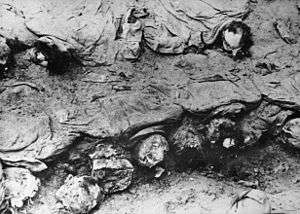Mass graves from Soviet mass executions
| Mass repression in the Soviet Union |
|---|
| Economic repression |
| Political repression |
| Ideological repression |
| Ethnic repression |
Mass graves in the Soviet Union were used for the burial of mass numbers of citizens and foreigners executed by the government of the Soviet Union under Joseph Stalin.[1] These mass killings were carried out by the security organisations, such as the NKVD, and reached their peak in the Great Purge of 1937–38.
Following the demise of the USSR in 1991, many of the killing and burial sites were uncovered,[2][3][4] one as recently as 2010.[5]
- Bykivnia Graves – containing an estimated 100,000–225,000 corpses[6][7]
- Kurapaty – estimations range from 30,000 to 200,000 bodies found[8]
- Butovo – over 20,000 confirmed killed[9]
- Communarka - about 10,000 killed [10]
- Sandarmokh – over 9,000 bodies discovered[11]
- Kolpashevo - over 1,000 bodies discovered in 1979, and then disposed of on instruction of the local party chief.[12]
- In the areas near Kiev alone, there are mass graves in Uman, Bila Tserkva, Cherkasy and Zhytomyr.[13]
- Katyn massacre
- Vinnytsia massacre
- In July 2010, a mass grave was discovered at St. Petersburg, which contained the corpses of 80 military officers executed during the Bolshevik "Red Terror" of 1918-21.[14]
- Dem'ianiv Laz
Gallery
-

Katyn 1943 exhumation. Photo taken by Polish Red Cross delegation.
-

Memorial cemetery Krasny Bor near Petrozavodsk, Russia
-

Butovo firing range near Moscow
See also
References
- ↑ "Documenting the Death Toll: Research into the Mass Murder of Foreigners in Moscow, 1937–38" By Barry McLoughlin, American Historical Association, 1999
- ↑ "Mass grave found containing Stalin victims" LA Times-Washington Post News Service, July 13, 1997
- ↑ "Mass grave found at Ukrainian monastery", BBC, July 12, 2002
- ↑ "Wary of its past, Russia ignores mass grave site", by Fred Weir, The Christian Science Monitor, October 10, 2002
- ↑ Stalin-era mass grave yields tons of bones Reuters. June 9, 2010
- ↑ "Ukraine reburies 2,000 victims of Stalin's rule". Reuters. 27 October 2007
- ↑ (English) Michael Franklin Hamm (1995). Kyiv. Princeton: Princeton University Press. ISBN 0-691-02585-1.
- ↑ Twentieth Century Atlas - Casualty Statistics - Biggest Battles and Massacres - Kuropaty
- ↑ "Former Killing Ground Becomes Shrine to Stalin’s Victims" by Sophia Kishkovsky, The New York Times, June 8, 2007
- ↑ Спецобъект "Монастырь" izvestia.ru.
- ↑ "Pictorial essay: Death trenches bear witness to Stalin's purges" CNN, July 17, 1997
- ↑ Hochschild, Adam. "The Secret of a Siberian River Bank". nytimes.com. New York Times. Retrieved 29 April 2016.
- ↑ Hiroaki Kuromiya, The Voices of the Dead: Stalin's Great Terror in the 1930s. Yale University Press, December 24, 2007. ISBN 0-300-12389-2 p. 23
- ↑ More 'red terror' remains found in Russia UPI, July 19, 2010.
This article is issued from Wikipedia - version of the 7/28/2016. The text is available under the Creative Commons Attribution/Share Alike but additional terms may apply for the media files.
_-_panoramio_-_Andrej_Ku%C5%BAnie%C4%8Dyk_(13).jpg)
